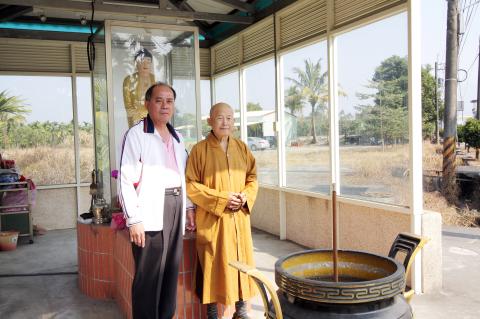Before road safety conditions are improved, people often erect Buddhist statues at dangerous intersections to petition the Buddhist lineage to bless and protect passersby. Seven years ago Shih Kuo-chuan, formerly head monk at Fo-En Temple in Pingtung County’s Ligang Township, made a vow to donate Buddhist statues, and to date more than 100 of the statues he has donated have been placed at such intersections. Shih, 77, has decided this year to donate his last Buddhist statue and is currently looking for an ordained location to put it so that **commuters** can be protected.
Shih says that seven years ago, receiving inspiration from “Amitabha’s 48 vows,” he made a vow to donate 48 Buddhist statues. As people continuously donated private land near dangerous intersections in hopes of erecting Buddhist statues to keep commuters safe, however, he ended up donating more statues than initially expected. Statues donated by Shih can be found as far away as Greater Tainan’s Meiling area, and he no longer remembers exactly how many statues have been donated.
Shih’s Buddhist statues can be seen at every intersection in Pingtung County’s Chaojhou Township where car accidents frequently occur. The lighting equipment surrounding the statues **illuminate** intersections that had previously been dark, which Sihchun Borough Warden Huang Tsai-sheng says actually has reduced the number of traffic accidents. People slow down when they see Buddhist statues at intersections. The residents of his borough are **grateful** for Shih’s good deeds, Huang says, adding that in private everyone calls him a living bodhisattva.

Photo: Chiu Chih-jou, Liberty Times照片:自由時報記者邱芷柔
Shih says that it costs around NT$100,000 to have a Buddhist statue manufactured. In the past, the cost was usually covered by donations from local temples, he says. Half a year ago, however, Shih decided to retire from his post as head monk, as he was getting on in years, and used his savings to have Buddhist statues made. Shih still has one more statue to donate and hopes to find that last fateful intersection in need of a statue before he dies, giving it a proper place to sit and protect the area.
(Liberty Times, Translated by Kyle Jeffcoat)
在道路安全未改善前,常見民眾在危險路口豎立佛像,祈求佛祖保佑平安,原在屏東縣里港鎮佛恩寺擔任住持的法師釋果川,七年前發願捐贈佛像,累積至今已捐出逾百座路口佛像,七十七歲的釋果川決定今年捐出最後一尊佛像,目前正積極尋找「有緣地」,守護過路人安全。
釋果川說,他七年前以「阿彌陀佛四十八願」發願捐出四十八尊佛像,但陸續有民眾捐出危險路口旁的私人土地,希望豎立佛像保佑過路人平安,佛像就越捐越多,最遠到台南梅嶺都有他捐贈的佛像,詳細的數目也記不清了。
屏東縣潮州鎮常發生車禍的路口,都能看見釋果川豎立的佛像,四春里里長黃財盛說,佛像四周的照明設備讓原本陰暗的路口變亮,確實減少車禍發生,民眾看見佇立在路口的佛像也會減速慢行,里民們相當感念釋果川的善行,私底下都稱他是活菩薩!
釋果川表示,一尊佛像造價約需十萬元,以往多由寺廟香油錢供養,半年前他自認年事已高,退下住持位置後,利用自己的積蓄打造佛像,現在剩下最後一尊,希望能找到需要路口佛像的有緣地,在他有生之年,讓最後一尊佛像安坐,守護地方。
〔自由時報記者邱芷柔〕

A ‘Dutch angle’ is a classic camera technique that has been used in filmmaking since the 1920s, when it was introduced to Hollywood by German Expressionists. Why is it called the Dutch angle if it’s actually German? In fact, it has no __1__ to the Netherlands. The term “Dutch” is widely believed to be a misinterpretation of “Deutsch,” which means German in the German language. In any event, the name stuck, and the Dutch angle remains a popular cinematic tool to this day. This technique involves tilting the camera on its x-axis, skewing the shot to create a sense of

A: After “God of Songs” Jacky Cheung sang for late singer Khalil Fong recently, music streaming service KKBOX also paid tribute to Fong by releasing his greatest hits online. B: The 20th KKBOX Music Awards ceremony is taking place at the K-Arena in Kaohsiung tomorrow. Fong performed at the ceremonies in the past. A: Who are the performers this year? B: The performers include Taiwanese groups 911, Wolf(s), Ozone, Singaporean pop diva Tanya Chua, and K-pop group Super Junior. A: South Korean stars actually took four spots among KKBOX’s 2024 Top 10 singles, showing that K-pop is still

Historians are rethinking the way the Holocaust is being presented in museums as the world marks the 80th anniversary of the liberation of the last Nazi concentration camps this month. Shocking images of the mass killings of Jews were “used massively at the end of World War II to show the violence of the Nazis,” historian Tal Bruttmann, a specialist on the Holocaust, told AFP. But in doing so “we kind of lost sight of the fact that is not normal to show” such graphic scenes of mass murder, of people being humiliated and dehumanized, he said. Up to this

Dos & Don’ts — 想想看,這句話英語該怎麼說? 1. 能做的事都做了。 ˇ All that could be done has been done. χ All that could be done have been done. 註︰all 指事情或抽象概念時當作單數。例如: All is well that ends well. (結果好就是好。) All is over with him. (他已經沒希望了。) That’s all for today. (今天到此為止。) all 指人時應當作複數。例如: All of us are interested in his proposal. All of us are doing our best. 2. 我們這麼做有益於我們的健康。 ˇ What we are doing is good for our health. χ What we are doing are good for our health. 註︰以關係代名詞 what 引導的作為主詞的子句,動詞用單數。如: What he said is true. 3. 大家都沿著步道跑。 ˇ Everybody runs along the trail. χ Everybody run along the trail. 註︰everyone 是指一大群人,但在文法上一般用單數。 4. 桌上有一本筆記本和兩支筆。 ˇ There were two